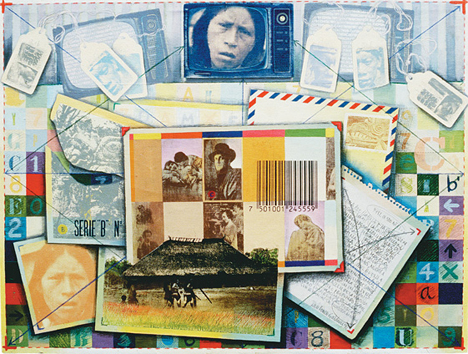ROMEO GALDáMEZ
PEOPLEText: Erika Saca
Do you consider yourself obsessive?
In the apparent chaos of my work there’s order, and in that sense there has to be rigor in taking care of proportion, sizes, colors, balance. “The unity in variety and variety in unity” as Kandinsky said. There’s an intention behind each work, and it requires an internal surgery. I want it to achieve an impact; I want it to communicate, to generate emotion, sensations and feelings, to touch people’s conscience.

Romeo Galdámez “Libro Escolar Objetivo, 58210… oh my code” (2001)
So, are you obsessive?
Without falling into any pathology, obsessed in achieving an objective. They say people from my zodiac sign, Capricorn, are stubborn, like goats trying to get to the top of the hill.
Serigraphy had been, almost exclusively, associated with posters, utilizing high contrast and a limited amount of inks. I wanted to remove the stereotypes associated with serigraphy, give it new dimensions, value and take it to a new pictorial level, no matter what it took. My pieces have an average of 100 inks. My obsession has nothing to do with getting the job done in time. Some of my pieces take up to six months to make. So it’s not a battle with time, it’s a battle with concepts, and the structure of my work. In order to demystify the concept of serigraphy being flat, I had to work it in various “layers” to give it more dimensions. Sometimes an area of 10 centimeters can take up to 20 different inks to highlight a small piece of lace, for instance, and even a month of work, in order to achieve my goal. If that’s obsession, I guess I’m obsessive. (Laughs)
I was just about to ask about that… Why did you choose serigraphy, your redefinition of serigraphy, and collage?
I took on Graphic Art because I’m interested in its multiplicity. The reproduction aspect of serigraphy excited me, when I first discovered it, because I could create a piece that would get to more people. The lower cost was also a factor in choosing serigraphy. I could create a single painting valued in $5,000 but with serigraphy, I could make a series of 20 and divide the cost in 20, and 20 people can have my work. It’s an ideological matter, because there are artists that don’t want to see their work reproduced, as well as a collector that doesn’t want another person to have the same piece. It also demystifies the concept that a work of art has to be unique.
Collage was my way of reflecting our contemporary world, one of cultural fusion, hybrid cultures. I didn’t want to make romantic post cards; so many others do this, and do it well.

Romeo Galdámez “Nuestramérica 500 Latina” (1992)
There are a few recurring themes in your work: the heart, indigenous people… Tell us a little bit about them.
My work is not abstract or intimate, it’s very sociological, and therefore, different elements of my exterior world appear repeatedly. I approach people and their context, their objects and events. I register this range of images that speak of a historical moment.
I made a series on the 500 years of the encounter of the old and new world. There were images of Mayas and of the Spanish conquest merged with elements of the Mass Media. It’s a fusion of images of our past, present and elements of our identity. We’re transforming into a new culture, the identities of our ancestors are becoming extinct. This is the theme of my installation, MOMENTUM, which calls us to reflect upon where we’re going and where we are.
Although cultures are ever changing, not something static, sometimes we’re in disadvantage to others that have much more influence to change us. Our country is in a process of change.

Romeo Galdámez “Apropriaciones del Territorio”
A new recurring theme is the “@” symbol that I’ve used in one of my latest works “Apropriaciones del Territorio”. It’s a vision of an author that traveled the world and therefore knows that the universe is wider than this country. The citizen is part of a universe, his country is not everything.
Read more ...




